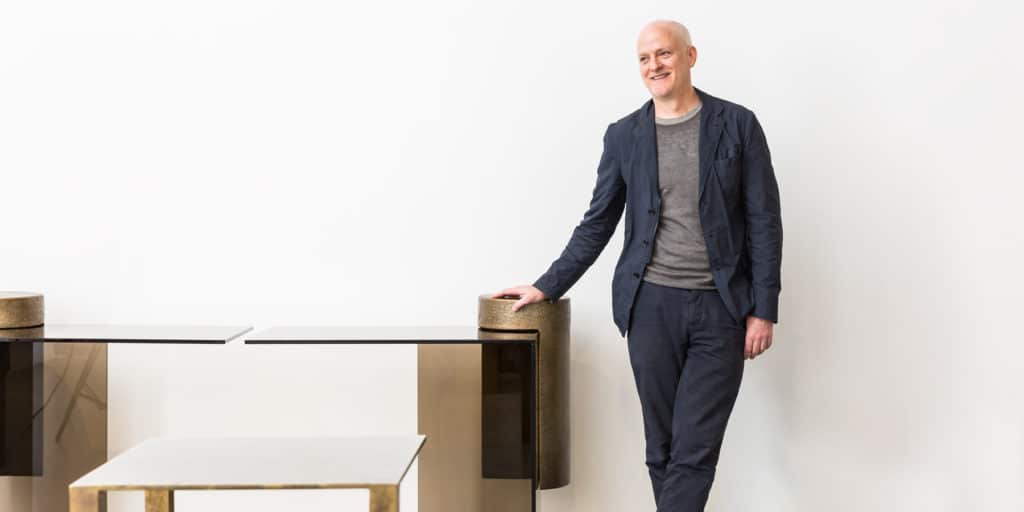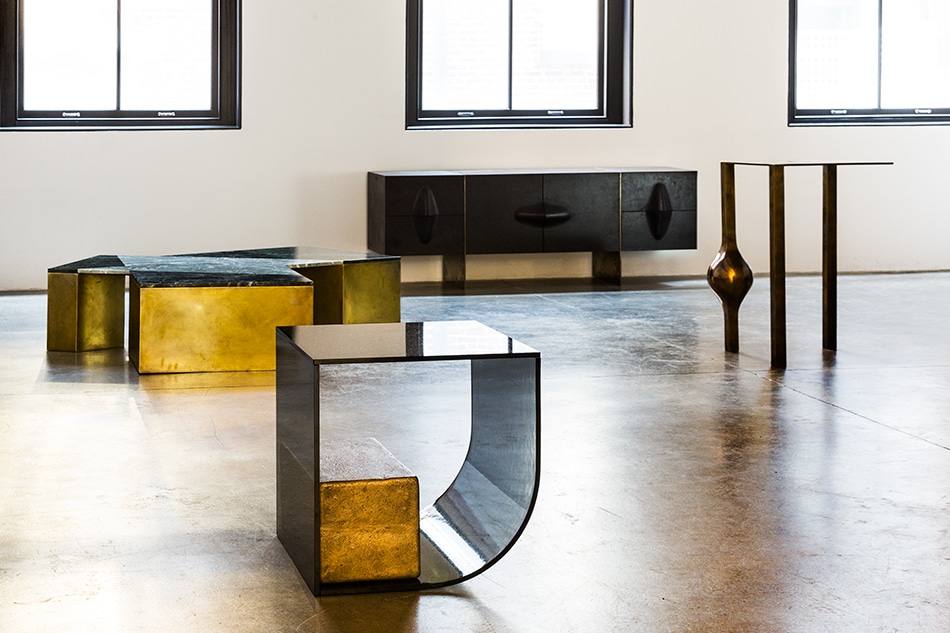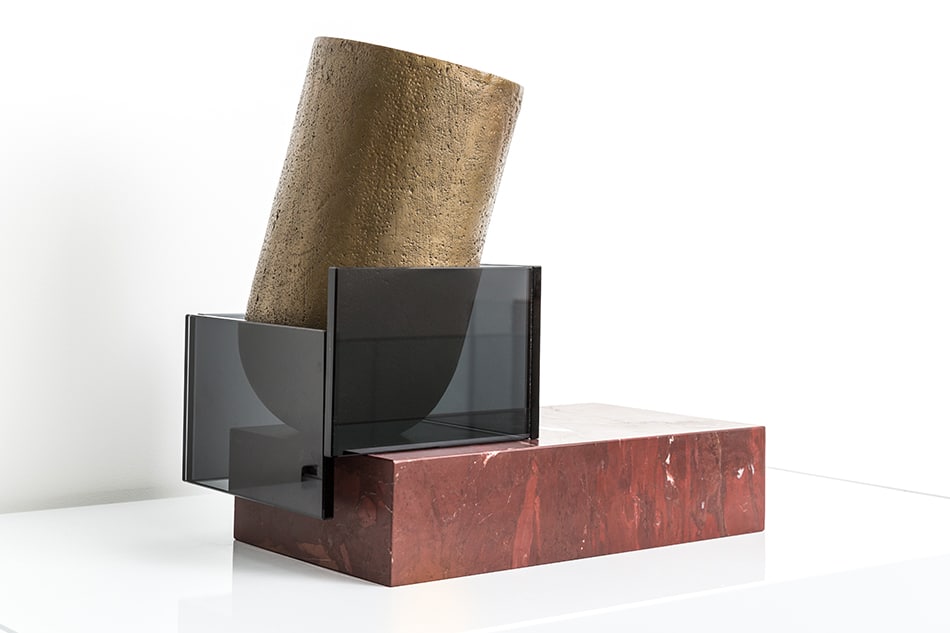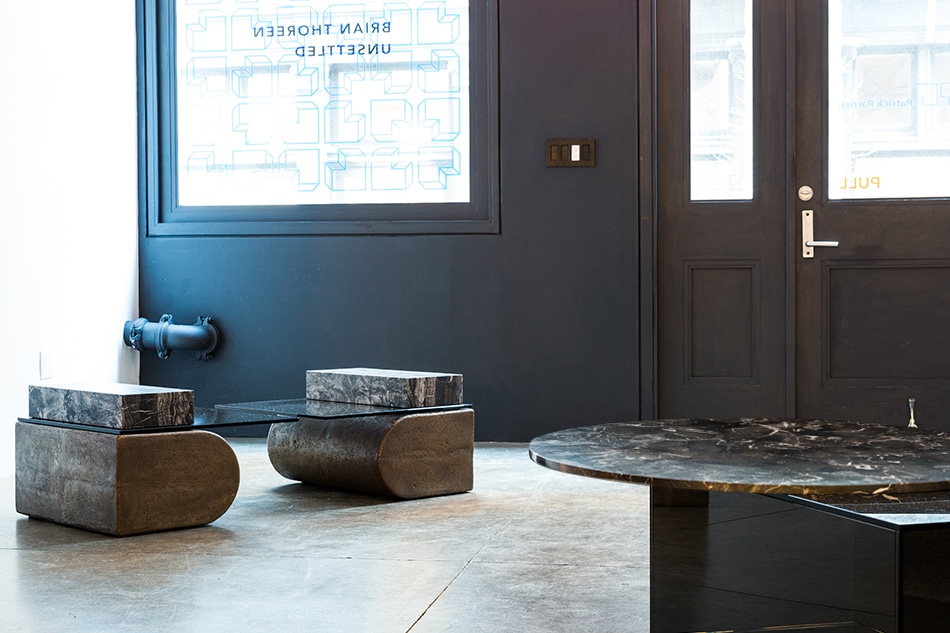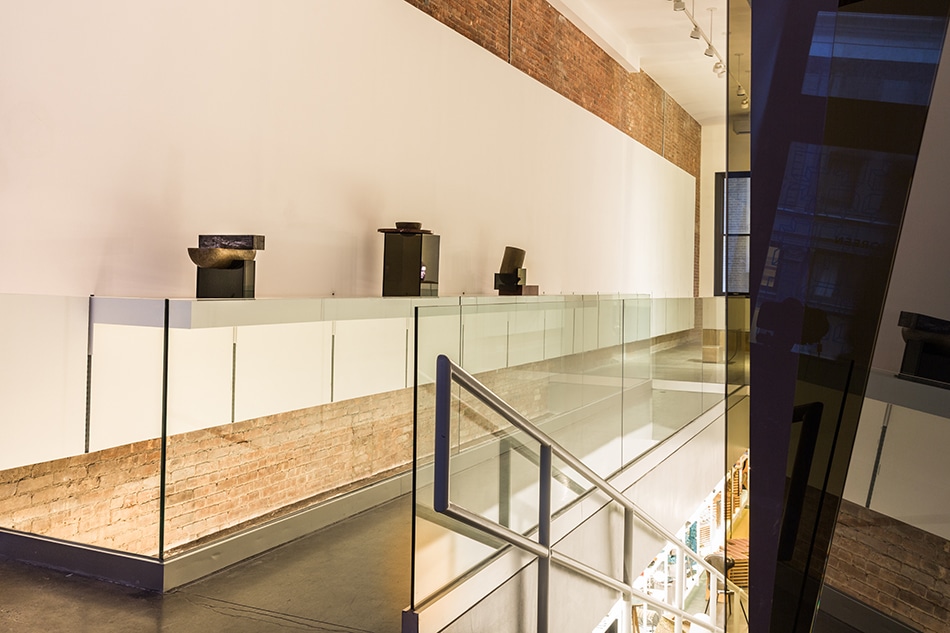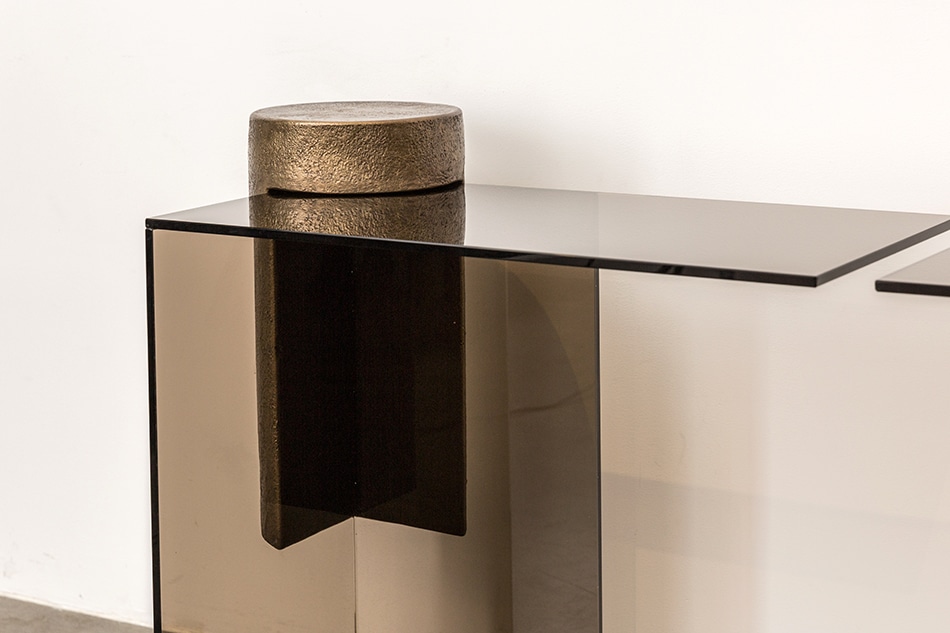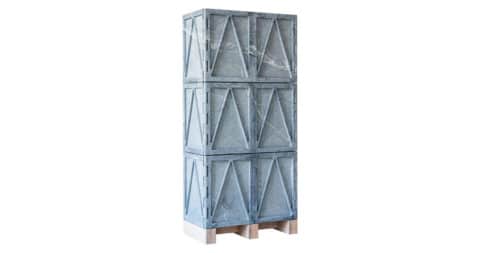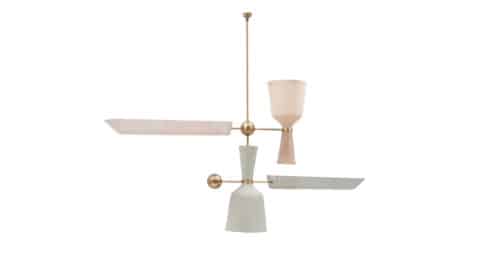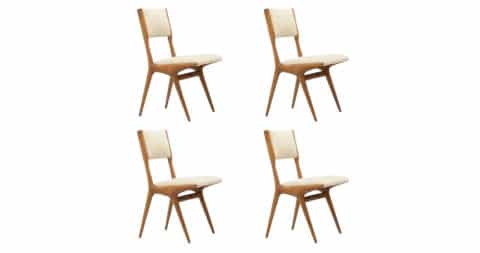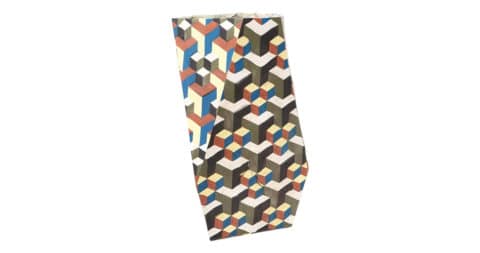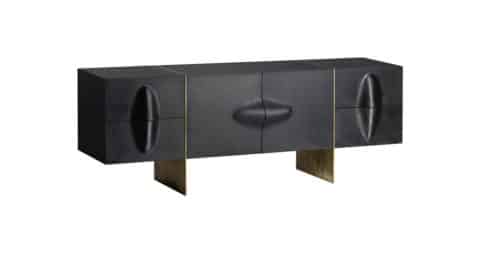
March 6, 2017Over the last seven years, New York design gallerist Patrick Parrish — seen at top with Brian Thoreen‘s Reaching console, 2016, and Growth table, 2015 — has expanded his purview beyond vintage modern furniture to include contemporary fine design. Above: Thoreen’s new collection, which includes this Cantilever table, 2017, is on view in a solo show at Parrish’s eponymous Tribeca gallery through March 25.
Design dealer Patrick Parrish has been undergoing a multifaceted cleanse. Last month, he was not only wrapping up a three-week body detox but also emptying out the street-level floor of his airy Manhattan gallery to make way for his latest exhibition. This is the first time he will have completely cleared the space for a single designer — a vote of confidence from a dealer with a track record for identifying emerging talent.
The focus of his attention? Brian Thoreen, a Los Angeles–based talent who set the design cognoscenti atwitter in 2015 at New York’s Collective Design Fair, where he showed a three-legged coffee table topped by different types of marble and a credenza covered in rubber.
Thoreen’s new collection of furniture, on view at Patrick Parrish through March 25 in the designer’s first-ever solo show, is exhilaratingly precarious. His Reaching console consists of two single-legged smoked-glass halves with hefty cylindrical cast-bronze counterweights that keep them from falling over. Side tables are topped by thick hunks of marble that hold cantilevered glass tops in place. A freestanding mirror remains upright thanks to a circular bronze support that looks as if it could easily roll out of place. Named Unsettled, the collection marries fragile and tough materials by finding equilibrium. Even more remarkable: None of the pieces use fasteners of any kind.
“I was trying to bring tension and uncertainly to every piece,” says Thoreen, who got his start as a carpenter with the L.A. architecture firm Marmol Radziner and as a builder of large-scale art installations by working for the likes of James Turrell, Peter Wegner and Tony Delap. “The idea is that no one component can exist on its own — it all needs the support of the other components in order to function.”

Thoreen’s marble and brass coffee table uses a mix of stones.
“You might think those bronze counterweights on the console are decorative elements,” Parrish points out, “but if you were to lift them off, the tables would destroy each other.”
It’s his passion for this sense of the unexpected that has helped Parrish attract a roster of high-profile clients. His gallery’s customers include top designers like Peter Marino and Roman and Williams, celebrities such as Michael Stipe and Mary-Kate and Ashley Olsen and the occasional institution like New York’s Museum of Modern Art.
Life wasn’t always so heady. Born in Atlanta and raised in Pensacola, Florida, Parrish originally wanted to be a fine art photographer. While studying at Florida State University, he stumbled upon the 1987 exhibition “The Machine Age in America” at the High Museum of Art in Atlanta, which stoked an interest in design. “It blew me away,” says Parrish. “I bought the catalogue and poster and started going to every thrift shop looking for that stuff.”
Following a move to the Midwest to pursue an MFA at the School of the Art Institute of Chicago, he befriended Richard Wright (long before he founded his eponymous auction house) and Wright’s then-partner Martha Torno (who now runs Modern Times). “I bought an Eames chair from them, my first piece of modern furniture ever, in an antiques mall,” says Parrish. Upon learning that Parrish was a photographer, Wright and Torno hired him to shoot some of their inventory.
But he’ll never forget the day he decided to become a dealer. “I bought a little side table on the street for ten dollars,” recalls Parrish. “I had no idea what it was.” Wright and Torno identified it as George Nelson and helped him sell it. “They got me twelve hundred dollars for it, which was three months rent,” says Parrish. “Right then, I said ‘Forget this art stuff. I’m going to be an antiques dealer.’ ”
He began as a picker, going door to door in his truck to sell his finds to dealers. He came to New York in the late 1990s, doing the same thing. Then, in 2000, he opened his first gallery, Mondo Cane, in Manhattan’s Chelsea district. Gradually, he developed a reputation as a knowledgeable purveyor of 20th-century American, Italian and Scandinavian design. When blogging became popular a few years later, he jumped right in to the medium by launching Mondoblogo as a place to write about the designers he was researching. More recently, he has redirected his attention to an Instagram account with more than 42,000 followers.

While Thoreen’s works have taken over the gallery at street level, Parrish’s downstairs space is filled with a variety of vintage pieces.
In 2010, Parrish took his first step into contemporary design, mounting an exhibition of plywood and flakeboard chairs and tables by the Minneapolis-based studio RO/LU. “I staged that show just because it was something I wanted to do,” says Parrish. “I expected the vintage to pay for the contemporary.” Much to his surprise, however, the RO/LU work sold very well. “The fashion designer Phillip Lim was a big proponent,” he says, “and he furnished many stores and his house with it.”
Since then, contemporary design has become a central part of Parrish’s business. His recent finds include faceted ceramic vessels with intricate multicolored patterns by Cody Hoyt; muscular cabinets made from solid stone and armchairs formed exclusively from leather by Fort Standard; and articulating, expandable furniture and mirrors by Ian Stell.
“I gravitate toward people who are honest about the materials they’re using but use them is an innovative or unusual way,” says Parrish. “No one I work with is doing anything strictly for decoration.”
In 2014, Parrish moved to his current space, at 50 Lispenard Street, in Tribeca, and changed the gallery’s name to his own. This April, he will launch a second enterprise: Fisher Parrish, an art gallery in Bushwick, Brooklyn, created in partnership with Zoe Alexander Fisher, a founder of the now defunct 99¢ Plus and Handjob galleries.
Although his personal tastes often skew toward brute simplicity, Parrish’s tendency to collect everything that inspires him has led to a life that’s anything but pared down. “I’m a minimalist trapped in a maximalist’s body,” he says, “one hundred percent.”
Parrish recently spoke with Introspective about vintage furniture and contemporary fine design, and what he looks for in each.

Parrish poses in his gallery with Thoreen, sitting atop one of the designer’s marble and brass coffee tables.
What makes an object gallery-grade design?
I get a lot of people sending me work, and a lot of it depends on whether it’s something I haven’t seen before, as well as the quality of construction. When I was in grad school, I put a big sign over my studio door that said, “It’s all been done before” — and I still believe that. So, I feel it’s very important for designers to know what came before them. Then, they should take that information and do something unique. If I see something that’s just derivative, it’s immediately out. If I see something that’s poorly made, unless that’s the point of it, it’s immediately out.
Are editions important for collectible contemporary design?
Yes and no. Editions matter to people willing to spend the money. They want to know if they have one of ten or one of twenty. But I personally don’t think it’s that important. If a cabinet is fifty thousand dollars, you’re not going to sell too many of them. Will you even sell ten? Maybe, maybe not. I also think it’s limiting to the artist, and to designers. Let’s say Brian Thoreen does a great chair, and it’s an edition of eight. What if someone wants ten for their dining room? Finally, I don’t always trust editions. Sometimes, someone will do an edition of ten tables — then, they’ll raise the height a few inches and say it’s a new edition. That happens a lot.
What do you look for in vintage furniture?
The condition is always a big issue. I do not like to restore things at all. Some dealers have customers who want pieces to be shiny, bright and perfect. But those aren’t my customers. I mostly leave things as they are, even if they’re beat up. Or if I touch them, it’s just very, very lightly. I want the finish of the piece to have some integrity to it. I also look for special and unusual pieces — finding prototypes is a dream.
TALKING POINTS
Patrick Parrish shares his thoughts on a few choice pieces.
